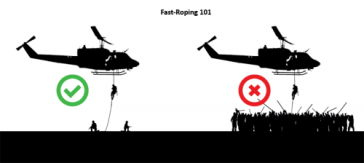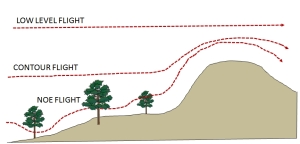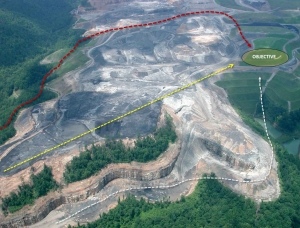I’ve been asked in more than one email to address ways to counter helicopters inserting in your Area of Operations (AO). I’m of the belief if you’re dealing with a helo threat then it’s probably a good time to shag out. Truth be told it’s going to be pretty hard to develop passive defense measures to counter a helo insertion threat. Remember: we’re covering passive defense measures – active ones come later on. Helos are highly mobile and vertical insertion techniques allow a threat to put boots on the ground in a matter of minutes. The element of surprise is why the military along with more and more law enforcement agencies are employing vertical insertion via helo. Given the operating characteristics and capabilities of the platforms themselves it’s going to be almost impossible to completely block their ingress and insertion. Think about it for a second – you’re typically going to be contending with a platform capable of flight that can appear over an area and insert multiple people into a confined space while hovering at a hundred feet. Is all lost? No you can hamper that platforms ingress by denying it easy access while at the same time creating a battlespace that allows you to channel it’s cargo – the dismounted threat.
By now if you haven’t noticed I’m not addressing attack aviation (aka attack helos) here. Why? Realistically they can and will stand off exploiting their capabilities which allows them a degree of protection and mutual support that most obstacle types aren’t suitable to counter. Nope this entry is going to address cargo birds – they kind that deliver people.
To counter any threat capability you have to understand it’s operational characteristics and limitations. Helos use three types of flight paths when they ingress. Those three being Low Level, Contour, and Nap of Earth (NoE) which are illustrated below.
Common sense dictates as an aircraft flies lower it’s collision risk increases which is why you will often see aircraft fly level until the situation dictates they fly either contour or NoE. Also the competency level of pilots is directly correlated to their echelon type. Pilots from the 160th Spec Ops Aviation Regiment are going to be light years ahead of pilots from the San Diego Sheriff’s Office in terms of skills and proficiency. Where the 160th jocks may get to practice NoE routinely under blackout conditions using night vision trying to scare the living bejeezus out of their cargo most of the civilian pilots out there don’t get the same level of practice simply because it’s dangerous and creates huge liabilities. Anyway pilots will also use terrain masking during flight to hide their presence. The better the pilot the more they will exploit the terrain. Study the illustration below for a second:
I’ve presented three flight paths as indicated by the colored lines. The yellow line presents a low level or possibly even contour flight path to the objective (the LZ or assault location) however it also allows the aircraft to be seen for the longest period of time given the altitude required to clear the ridgeline. The white line reduces the amount of exposure time by coming in using contour or NoE flight along the cliff and doesn’t come into view until it breaks that spur on the eastern edge. Better but not the best. The flight path indicated by the red line using contour and NoE while being masked by the ridgeline until it crosses the northern edge of that terrain feature gives it the least amount of exposure time – which reduces the amount of reaction time for anyone on the objective. In reality you would probably see both the red and white line used. Remember anywhere there’s multiple paths to an objective the threat is more than likely to exploit them so don’t develop tunnel vision focusing on one area.
So what can we do about this? Let’s make some of that terrain work for us. years ago I had a good friend and drinking buddy that was a pilot in the 160th who had struck a host nations communications wire strung across a valley during a training mission. He was in low level flight using terrain masking at the time and it damaged his bird bad enough to force an emergency landing – creating a mess for the mission commander to have to deal with. Wire strikes are a leading cause of rotary wing crashes every year especially in military helos. Something as simple as a hundred bucks worth of wire strung across a valley incapacitated a multimillion dollar bird. One of those birds has an emergency and as I wrote you’ve complicated any plan the threat may have had. Complicate it bad enough and he may have to scrub to regroup and try again.
For SnG let’s look at the typical run-in to a landing zone for an actual landing. Once again given proficiency levels we’ll take the best bet guess – the active military requirement. Plan for that and everything else should be covered. Planning dictates that you should have a minimum of 30 meters from a Blackhawk (35 for a twin rotor like the Chinook) landing zone that is obstacle free. This includes keeping the aircraft at least 35 meters away from tree lines. Now typically when an aerial assault is going to happen by aircraft that actually land they will choose a landing zone (LZ) away from their objective but close enough for their cargo to still assault without covering a long distance. Now it’s time to go back to the terrain and take another look at it and its surrounding terrain as well. Using the factors above you want to identify any location in your AO that is a minimum of 60 meters in diameter cleared and fairly level without tree cover for another 5 meters past that.
So now that we’ve identified those LZs what can we do about them? An easy fix is to put an obstacle in that breaks that area. Something as simple as a ten to fifteen foot pole with guide wires running out to the surrounding tree lines ruins a landing site. If you have a stock tank a windmill would be a good obstacle that wouldn’t be questioned. Rule of thumb: the taller and more wires the better. Similarly if you have a suitable landing site near a bridge that has a superstructure running guide wires out from it to posts in the ground will accomplish the same thing. Use your creativity to disrupt any clear area working from the inner part of your AO to the outer part. How far is far enough? It really depends on the threat you anticipate. If a Sheriff’s Office is going to raid you but can’t find an LZ within 2 kilometers then chances are they do it in ground vehicles instead. A highly trained military force? You aren’t going to be able to push them far enough out to deter them.
OK we’ve taken care of some of the ways they ingress and landing zones. What next? The next threat would be from rope insertions (rappelling and fast roping). I’ll state it again – a Blackhawk can swoop in and drop a squad on your rooftop in a minute. There’s not a lot you can do to counter this type of tactic other than creating clutter and adding obstacles in areas and locations you believe that rope insertions would occur. As always don’t create cover for a threat when laying in clutter. A wise man might leave one area open that he could use as an observed fire zone that would seem to be a sweet LZ for insertion. This is where wire obstacles could come into play – and we’ll be getting to them shortly.
What about tree lines and dense woods? Yup they can be roped into – I’ve done it and hated the hell out of it. There’s not a whole lot you can realistically do to counter that tactic. Instead focus on the approaches to your homestead from logical insertion sites using the same basic logic the threat will. That being if there’s a clear place to insert away from the objective versus taking a risk and inserting into dense clutter that route will be used almost every time. Especially by a less trained and competent threat.
As always use your imagination tempered with a realistic approach and threat analysis. Get the gears grinding and next time you’re out and running around in your AO look at those clearings and think about how you could spoil a helo insertion.
For those that are screaming for more active types of countermeasure Tactics, Techniques, and Procedures (TTPs) there’s a couple of books you can dig into:
The Canadian Army has a volume entitled All Arms Air Defense that’s a good little read.
Additionally the US Army published a manual entitled Combined Arms for Air Defense.
Also there is a book entitled Guerrilla Air Defense: Antiaircraft Weapons And Techniques For Guerrilla Forces by James D. Crabtree- an actual Air Defense Officer – published by Paladin Press. I’ve read it and although I’m not fond of a lot of the examples in the book (fixing an automatic weapon to a stump in a cleared area doesn’t strike me as such a great idea along with some others in this book) it does serve as a decent primer for Air Defense theory. I think it’s out of print however as always Google is a good bet.



